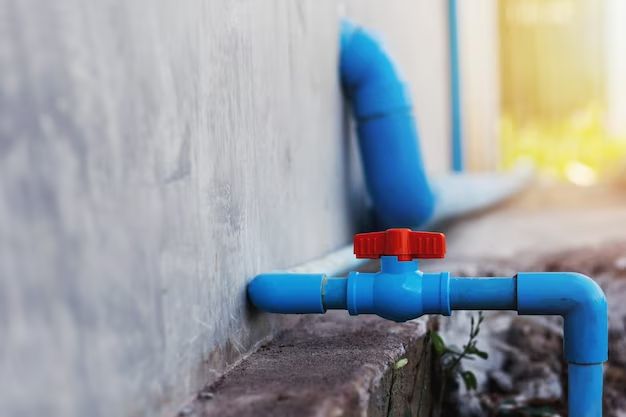Plumbing systems commonly use a combination of different pipe materials, including PVC plastic and metal piping. Connecting these different materials requires using the right fittings and techniques to create secure, leak-proof joints.
Page Contents
Can PVC Be Glued to Metal?
No, PVC and metal pipes cannot be directly glued together using solvent cement or other adhesives. PVC is made of plastic while metal pipes are made of materials like copper, galvanized steel, or stainless steel. The different materials are not compatible for direct gluing or welding.
Using Transition Fittings
Instead of gluing, the proper way to join PVC to metal plumbing is by using transition fittings that are designed for connecting different types of pipe material. There are transition fittings made specifically for joining PVC to copper, galvanized steel, or other types of metal pipe.
PVC to Copper Transition Fittings
For joining PVC to copper pipes, a PVC-to-copper transition coupling is needed. This type of fitting has one end with a PVC solvent-weld socket and the other end with a solder socket to connect to copper with a torch. An adapter can then be glued into the PVC end and the copper pipe soldered into the copper end with lead-free solder.
PVC to Galvanized Steel Transition Fittings
Transition fittings are also made for connecting PVC to galvanized steel or iron pipes. One common type is a PVC female adapter with one end that slides inside the metal pipe and has a metal retention ring to grip the interior of the pipe. The other end has a solvent-weld socket to glue into PVC pipe. This creates a strong metal-to-plastic connection.
PVC to Stainless Steel Transition Fittings
For stainless steel pipes, a PVC-to-steel transition union fitting allows connecting to PVC. It has a threaded steel end to connect to the steel pipe and a solvent-weld end to glue into the PVC. The two ends are joined by a threaded union nut for a versatile metal-to-plastic connection.
Transition Fitting Sizes
Transition fittings for joining PVC and metal pipes are available in a full range of common plumbing sizes. This includes fittings for connecting 1/2″ PVC to 1/2″ metal pipe, 3/4″ PVC to 3/4″ metal, and larger sizes up to 4″ PVC to 4″ metal pipe. Choosing the properly sized fitting allows the PVC and metal pipes to seamlessly integrate.
Using Threaded Connections
For some applications, threaded fittings can provide another option for connecting PVC and metal pipes. There are PVC male and female threaded adapters that can screw into threaded steel, iron, or copper fittings and components. This can create leak-free threaded PVC-to-metal connections without transition fittings.
PVC Male Threaded Adapters
A PVC male threaded adapter has male pipe threads on one end to screw into a female threaded opening on a metal valve, pipe, or fitting. The other end is a solvent weld connection to glue into PVC pipe. This allows threading PVC directly into metal components.
PVC Female Threaded Adapters
For screwing metal pipes or fittings into PVC, a female threaded PVC adapter can be used. This has female pipe threads on one end to screw a male threaded steel, copper, or iron pipe into. The solvent weld end connects to the PVC pipe. Threaded PVC adapters come in many common pipe thread sizes.
Proper Installation Techniques
When joining PVC and metal plumbing pipes and fittings, it is important to follow proper installation techniques to create secure, leak-free connections:
- Cut pipes square and deburr the ends so fittings can fully seat.
- Chamfer the outer edge of PVC pipe ends for easier insertion into fittings.
- Clean and prime PVC pipe ends before solvent welding.
- Use the appropriate PVC and metal pipe primers and cements.
- Allow glue joints to fully cure before pressurizing system.
- Make sure threaded connections are properly tightened and sealed with thread tape.
Advantages of Combining PVC and Metal
There are several advantages to using both PVC and metal for plumbing systems:
- PVC is lightweight, durable, and inexpensive.
- Metal pipes have strength for structural support.
- Together they can withstand pressure, corrosion, impacts, and temperature fluctuations.
- Transition fittings allow them to be securely joined as needed.
The ability to connect PVC to metal enables creating efficient, cost-effective plumbing using the ideal material for each section or application throughout the system.
Common PVC to Metal Plumbing Applications
Some typical applications for connecting PVC and metal in plumbing systems include:
Connecting Fixtures
Using PVC for main water supply lines and then transitioning to metal pipes when connecting to metal water fixtures and appliances.
Drainage Piping
PVC for non-pressurized DWV drainage piping connected to metal drain pipes leading to the municipal sewer line.
Underground Water Service
Installing underground PVC for on-property water service pipes and connecting to the municipal metal water supply line at the property boundary.
Irrigation Systems
Transitioning from PVC piping to metal sprinkler heads, control valves, and other components in irrigation systems.
| PVC to Metal Connection | Transition Fitting Used |
|---|---|
| PVC to galvanized pipe | PVC female adapter with metal retention ring |
| PVC to copper pipe | PVC-to-copper transition coupling |
| PVC to stainless steel pipe | PVC-to-steel threaded transition union |
Conclusion
Although PVC and metal pipes cannot be directly bonded together, there are effective methods for connecting them to combine their beneficial properties in plumbing systems. Using properly sized transition fittings or threaded connections adapters allows PVC and metals like copper, galvanized steel, or stainless steel to be securely joined for both pressurized and drainage applications.
With the right approach, PVC and metal can work together to create durable, high-performing plumbing. The ability to join them provides advantages that using only one material alone cannot provide.
